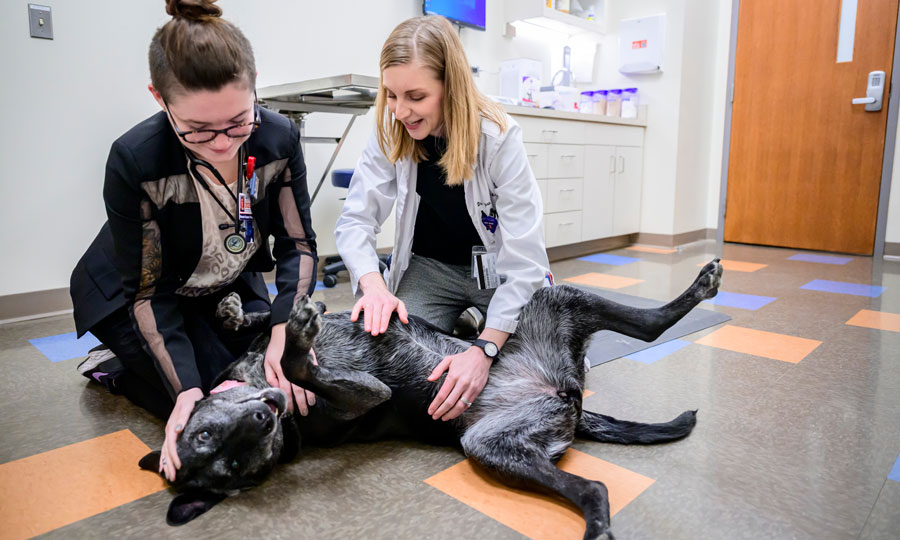Heart Murmurs Often Go Away By Six Months of Age
Although the occurrence is rare, some puppies are born with heart conditions that should be detected and treated as soon as possible to ensure that they lead a healthy life. Dr. Jordan Vitt, a veterinary cardiologist at the University of Illinois Veterinary Teaching Hospital in Urbana, says the three types of congenital heart defects seen most often are patent ductus arteriosus, pulmonic stenosis, and subaortic stenosis.
![[Dr. Jordan Vitt checks the heart of a white dog]](https://vetmed.illinois.edu/wp-content/uploads/2021/04/pc-vitt-kadotani.jpg)
“Either something didn’t form correctly in the heart or something didn’t regress appropriately in the heart of the unborn puppy,” Dr. Vitt explains. “This can cause blood to flow in abnormal pathways, resulting in heart murmurs.”
All three conditions result in heart murmurs, meaning the puppy’s heart sounds are not normal. However, each of these heart problems has its own cause and treatment.
Patent Ductus Arteriosus
Patent ductus arteriosus (PDA) is a condition in which a blood vessel that should close at birth fails to close. This problem can occur in any breed of dog.
“When puppies are developing in the womb, the lungs are not needed to oxygenate blood,” says Dr. Vitt. “The ductus arteriosus allows the blood to bypass the lungs, moving directly from the pulmonary artery to the aorta – which supplies oxygenated blood to the body. When puppies are born, this ductus should close and all blood flow through the ductus should stop.”
However, in patients with a PDA, the ductus remains open, or “patent.” According to Dr. Vitt, when this happens, blood that should flow to the body goes back into the lungs through the PDA. This can result in heart enlargement, leading to congestive heart failure if the problem is not detected and addressed.
To prevent this abnormal blood flow, the PDA should be closed. This can be performed by a surgeon by tying off the PDA through a surgical incision in the chest or minimally invasively by a cardiologist, like Dr. Vitt. The minimally invasive technique is performed by placing a heart catheter through the femoral artery to place a device that will occlude, or close, the ductus.
“A dog with a PDA will always have a more positive outcome if the ductus is closed,” says Dr. Vitt.
Stenoses
The other two types of congenital heart defects are characterized by valve “stenosis” or abnormal narrowing. This narrowing of normal passages makes it harder for the blood to move from the heart to the lungs or from the heart to the body. Stenoses may affect the pulmonic valve or the aortic valve.
“Large-breed dogs, such as golden retrievers, Rottweilers, and Newfoundlands, are more prone to subaortic stenosis, whereas small-breed dogs and bulldogs are more prone to pulmonic stenosis,” Dr. Vitt says.
These congenital heart defects may first be noticed by their owners when, after intense activity, the dog becomes weak or collapses, known as “syncope.” Weakness or collapse occurs after activity because exercise puts demands on the heart to send more oxygenated blood to the body. The narrowed or “stenotic” valves prevent appropriate blood flow for oxygenation of the brain, leading to a loss of consciousness, or “fainting.”
A minimally invasive procedure called a balloon valvuloplasty can resolve these stenoses. This procedure involves using a heart catheter to place a balloon at the stenotic valve. The balloon is then inflated to widen the valve opening and improve the flow of blood. The balloon is removed after the procedure.
“These patients do much better after the narrowed valve is open,” says Dr. Vitt.
In the case of subaortic stenosis, the problem is often caused by scar tissue located below the level of the valve, or “subvalvular” region. A newer technique for repairing subaortic stenosis begins with threading a smaller balloon, which when inflated exposes small surgical blades, to incise or cut the scar tissue before using a larger balloon to open up the narrowed valve region.
“These blades on the smaller balloon cut the scar tissue, which help to guide how the narrowed area in the heart will expand when the larger, high-pressure balloon is inflated,” explains Dr. Vitt.
All of these minimally invasive techniques are performed by the cardiology service at the University of Illinois Veterinary Teaching Hospital.
Early Detection
Because congenital heart defects are something puppies are born with, there is no way to prevent this disease. However, early detection and treatment improve the prognosis for the patient.
Dr. Vitt urges, “Please don’t immediately freak out if your puppy has a murmur. Most puppies have soft murmurs at a young age, and most murmurs go away on their own by the time the puppy is four to six months old.”
Heart murmurs are evaluated on a 6-point scale. A murmur that is characterized as a grade 2 or less is very likely to resolve; on the other hand, Dr. Vitt advises that a heart murmur at grade 3 or higher should be evaluated by a veterinary cardiologist as soon as possible. Any murmur that is still present at six months or that is getting worse should also be evaluated. The earlier the detection, the sooner the problem can be evaluated and potentially fixed for the best long-term outcome.
To encourage early detection of potential congenital heart defects, the cardiology service at the University of Illinois Veterinary Teaching Hospital offers a discounted price to “auscult” or listen to litters of puppies. If a problem is detected in any of the puppies, the owner may opt to have an echocardiogram or ultrasound of the heart as well.
In addition, the cardiology service will soon offer breed-specific screening days. On these days, dog breeds predisposed to certain heart diseases will be evaluated at a discounted price to encourage early detection and potential treatment.
“We always want to help animals in any way that we can, and it’s also a great excuse to have more puppy snuggle time,” says Dr. Vitt.
If you are concerned about your pet’s heart health, see your local veterinarian. To find out more about breed-specific screening days, contact the cardiology service at the University of Illinois Veterinary Teaching Hospital.
By Hanna Netisingha
Image by Lauren Rathbone from Pixabay

![[puppies]](https://vetmed.illinois.edu/wp-content/uploads/2021/04/pc-vitt-murmur.jpg)


